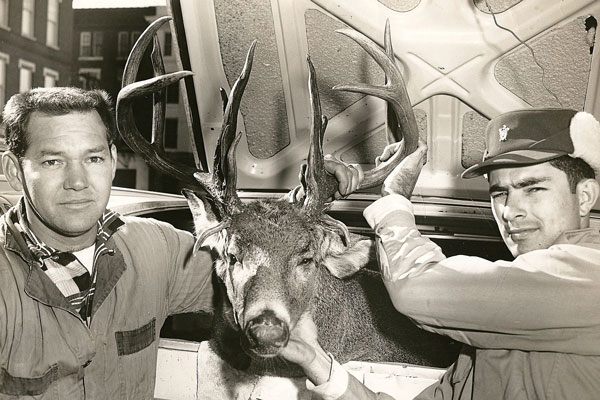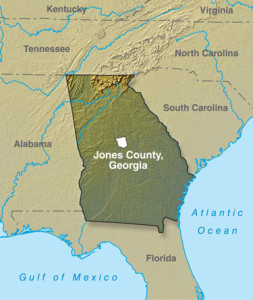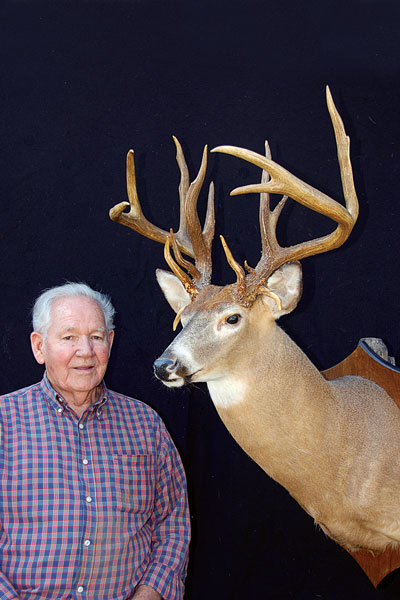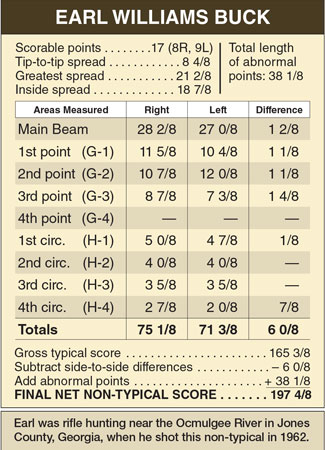November 24, 2014
By Bill Cooper
 Over the last 35 years, whitetail hunters in the Southeast have witnessed a remarkable evolution. During that span, the development and availability of equipment, innovations in hunting techniques, advances in land and deer management and easy access to information through various forms of media have been mind boggling.
Over the last 35 years, whitetail hunters in the Southeast have witnessed a remarkable evolution. During that span, the development and availability of equipment, innovations in hunting techniques, advances in land and deer management and easy access to information through various forms of media have been mind boggling.
However, if we go back just 20 years earlier, to the late 1950s and '60s, things were far different. Then the majority of hunters knew very little about whitetails, much less how to hunt them. There were no specialized stores filled with hunting gear. In fact, many small-town hardware stores that sold guns and ammunition stocked only shotguns and .22 caliber rifles, simply because there was little demand for centerfires.
In many southeastern states, such as Georgia, deer numbers during those years were only a small fraction of the population today. Nevertheless, there were some very big bucks walking the woods. And recently, one of
those giants finally came to light.
Advertisement
While Earl Williams shot the buck in Georgia's Jones County back in 1962, only within the past year has the deer been officially measured and entered into the Boone & Crockett record book. Fortunately, Earl, now 82, remains in good health and still hunts each fall. His account of taking this deer paints an interesting picture of do-it-yourself hunting in that bygone era.
No Deer to Hunt
 Earl grew up fishing and hunting small game in central Georgia, near Macon. Deer hunting was never an option; there wasn't a huntable population. However, thanks to Georgia Game & Fish Commission restoration efforts, which included stocking deer in the area during the '40s, a limited season was opened in several counties during the mid-'50s.
Earl grew up fishing and hunting small game in central Georgia, near Macon. Deer hunting was never an option; there wasn't a huntable population. However, thanks to Georgia Game & Fish Commission restoration efforts, which included stocking deer in the area during the '40s, a limited season was opened in several counties during the mid-'50s.
Advertisement
"I hunted every deer season," Earl says. "But I knew absolutely nothing about how to hunt. I read many of the deer-hunting articles in national outdoor magazines, but most were about hunting in the northern states and didn't seem applicable to Georgia.
"In those days there were no tree stands, blinds, camouflage or any of the other products available today," Earl notes. "I simply found a location with a good view of the surrounding woods and waited. But prior to 1962, I'd never seen a single deer while hunting."
Forget the Squirrels
On an early-September squirrel hunt on the Ocmulgee River with friend Billy Waits, Earl finally saw his whitetail luck take a turn upward. After securing their boat on a sandbar, the men began walking toward the woods. However, after just a few steps, Earl abruptly stopped and began staring at the ground. Directly in front of him were several large deer tracks.
The men immediately shifted their focus. They spent much of the morning scouting the bottom, in the process finding numerous other tracks.
"Today, no one would bother to look twice at a few deer tracks along the river bank," Earl says. "But at that time, it was really a big discovery for us. Squirrel hunting was put off until another day."
Feeling they had stumbled upon an ideal hunting location, the men initiated plans to figure out some way to reach the area by land. However, with few established roads in that section of the county, doing so proved to be anything but easy.
"Most of the land was owned by big timber companies," Earl remembers. "The woods roads were open and fairly accessible, but my only vehicle was a 1959 Ford sedan, so our travel was limited by rough terrain and weather conditions. Needless to say, there was a lot of trial-and-error driving and walking involved, but we eventually found the right combination of roads and trails to reach the area we wanted to hunt."
Earl knew by the paint colors of the marked boundary lines which timber companies owned which land. Just before opening day, he called the company office to tell them where he and Billy planned to hunt.
"In those days, there were no paid hunting leases or required permits," Earl points out. "Most of the timber companies simply asked hunters to notify their office in regard to the location, specific hunt dates and who would be hunting."
A New Season
Earl's first two hunting days at the new site turned out to be no different than his deer hunts in previous years. Nevertheless, he remained optimistic that his luck would change.
"During the third day of the hunt, I was standing next to a small creek, watching a wooded hillside," Earl says. "I hadn't heard a sound, but as I glanced off to the side, I was shocked to see a big doe standing 50 yards away in the middle of the creek, staring in my direction. After several seconds, the deer continued on across the creek and out of sight.
"That was really an exciting moment for me, because it was my first hunting encounter with a whitetail. The next morning I was back at the same spot just before eight o'clock."
Approximately 30 minutes after getting settled, the hunter detected a flicker of movement on the hillside. Within seconds, he spotted a doe about 60 to 70 yards away, walking parallel to his position in the creek bottom. In no apparent hurry, the doe slowly moved through the timber, eventually crossing an old, grass-covered logging road.
"A few yards past the old road, the doe suddenly stopped and looked back," Earl recalls. "When I glanced in that direction, I saw antlers moving above the brush. I picked up my rifle and maneuvered into a comfortable shooting position."
T he hunter was using a J.C. Higgins Model 45 lever-action rifle in .35 Rem. (The Model 45 was made by Marlin for Sears, Roebuck & Co. and was identical to Marlin's popular Model 336.) Although the rifle had no scope, Earl had fired it enough to know it was very accurate within 100 yards.
he hunter was using a J.C. Higgins Model 45 lever-action rifle in .35 Rem. (The Model 45 was made by Marlin for Sears, Roebuck & Co. and was identical to Marlin's popular Model 336.) Although the rifle had no scope, Earl had fired it enough to know it was very accurate within 100 yards.
As the hunter looked on, the buck continued to follow the doe's path along the hillside. Sixty yards from Earl, the big deer paused at the edge of the overgrown logging road.
"I had the rifle in position, and when the buck stepped into the road opening, I pulled the trigger," the hunter says. "At that distance I had no doubt about making the shot, but I was completely surprised when the deer instantly dropped in its tracks."
Unable to see the buck lying on the ground, and not being sure it was dead, Earl was hesitant to begin walking in that direction. He finally hollered for Billy.
"When I yelled, the buck suddenly reared up," Earl recalls. "But he fell back out of sight. That really unnerved me. Once Billy arrived and could see the deer was down for good, I walked on up the hill to it.
"It would be an understatement to say I was excited; it felt like my heart was beating 900 miles an hour. Since it was the first buck I had ever seen in the woods, I really had nothing to compare it to in terms of size. But it sure looked like a whopper to me."
Learning on the Fly
The two men spent several minutes examining the buck, counting a total of 17 antler points. They were then faced with the daunting task of field dressing the big whitetail.
"Neither one of us had ever field dressed a deer, or for that matter, seen one field dressed," Earl recalls. "By the time we finished the task, the deer and both of us were a bloody mess. Luckily, the nearby creek provided a means to clean up."
The next item on the hunters' agenda was to somehow move the buck approximately a mile to where the car was parked. That wasn't an easy chore, considering they estimated the dressed weight to be around 200 pounds.
"We tried tying the deer's feet to a long pole that could be supported on our shoulders," Earl says. "But we quickly found out that wasn't going to work, because the buck's head and antlers hung all the way down to the ground, making it impossible to walk. We finally decided dragging was really the only option."
Needless to say, that also proved to be an ordeal. But by early afternoon they had the deer loaded and were on their way to Macon.
"We spent a couple of hours driving around, showing the buck to our friends and families," Earl says. "We were then faced with the dilemma of what to do with the deer. In those days there were no coolers or processors who handled wild game. I finally contacted R.J. Lindsey, who owned a local bait and tackle shop, and he let me put the buck in his outside cooler. It took a few more days to find someone to do the butchering."
From the outset, Earl knew he wanted to have the buck mounted and made sure the cape was kept undamaged. But taxidermists were also in short supply at that time.
"I was unable to find any taxidermist in the Macon area," the hunter says. "Finally, after a month of searching, I contacted a man near Atlanta who agreed to do the mount."
51 Years Unscored
In the early '60s, few people were aware of antler scoring. Boone & Crockett's modern scoring system hadn't even started until 1950, and there was little publicity concerning large deer racks. The mount of this great Jones County trophy always attracted the attention of visitors, particularly other hunters. But while Earl and his sons, Ken and Richey, continued to hunt, the huge antlers from '62 remained unmeasured.
 "In the past, I had a number of people encourage me to have the rack scored," Earl notes. "I did obtain some information on antler measuring but made the mistake of thinking that all abnormal points were scoring deductions. I really didn't believe there was any point in pursuing it further."
"In the past, I had a number of people encourage me to have the rack scored," Earl notes. "I did obtain some information on antler measuring but made the mistake of thinking that all abnormal points were scoring deductions. I really didn't believe there was any point in pursuing it further."
But Earl's grandson, Josh, did think it was worth pursuing. Having grown up hunting with Earl and being around the huge mount his entire life, Josh always felt the buck was comparable in size to other B&C whitetails. And so, with his grandfather's permission, he contacted Georgia wildlife biologist and official measurer Bobby Bond in the DNR's Fort Valley office and scheduled an appointment.
Late last October, nearly 51 years after Earl had shot the buck, the rack was officially measured. Even after more than five decades of drying, the measurements were impressive.
Eight of the 17 points comprise a great 4x4 typical frame. The beams exceed 27 inches, and the brow tines average just over 11. The inside spread is 18 7/8 inches. Despite 6 inches of deductions for asymmetry, the typical frame still nets 159 3/8. After adding in the 9 abnormal points, which total 38 1/8 inches, the final non-typical B&C score is 197 4/8. Not only does the Williams buck exceed the 195 minimum for B&C's all-time record book, he now stands as the third-biggest Jones County non-typical ever scored.
Trophy Trends
The addition of this deer to the list means seven of the county's top nine bucks — all of which qualify for the B&C record book as non-typicals or typicals — were taken prior to '68.
Whitetail hunters today often are said to be living in the "golden age," and that never before has there been more opportunity to take a trophy buck. Certainly geographic region, method of hunting, etc. can in part define trophy status, but generally speaking, it's hard to argue against the validity of this statement for North America as a whole.
However, in regard to the era of Georgia deer hunting in which Earl took his great non-typical, there are also some statistics worth noting. From approximately 1957 to '71, this state produced 36 known whitetails that qualified for B&C entry. Yet this happened at a time when the state's overall deer population was barely high enough to justify hunting — and even then in only a few selected areas. In fact, in those days some counties were still being restocked with whitetails. As Earl can attest, hunting was definitely a challenge. Encountering any deer at all was reason enough to celebrate.
Despite such, in this part of the world there might never have been a better period in which to take a B&C deer. Years of protection, followed by short hunting seasons and virtually no pressure, had allowed a high percentage of bucks to mature. And with such low total deer numbers, along with active timber management, food was abundant. Put it all together and you had a situation lending credence to the old saying, "Tough hunting often earns big rewards."
Kyle Heuerman
Any serious whitetail hunter knows that it's not often that we get a second chance on the buck of a lifetime, or even a first chance for that matter. But luck was on the side of Kyle Heuerman and his girlfriend Jennifer Weaver when they put an arrow through this 196-inch Illinois brute.
Read the full story.Joe Franz
We estimate he was 7 1/2 years old. That's based on photos from 2010, when he clearly wasn't over 3 1/2. When I got him he weighed over 300 pounds on the hoof, as suspected.
Official B&C measurer Glen Salow came up with a 'green ' gross score of 258 7/8 inches. After the 60-day drying period, he again taped the rack. This time he got a gross non-typical score of 261 3/8, with a net of 230 7/8. The gross score evidently makes this the highest-scoring wild whitetail ever harvested on professional video.
Read the full story.Jon Massie
Jon's no stranger to free-ranging whitetails across the central plains, having guided a number of clients to trophies and harvesting many big ones himself. In fact, going into 2013 he'd shot two net Boone & Crocketts: one a non-typical scoring over 200, the other a typical from public land.
With such success behind him, Jon felt all of his hunting dreams already had come true. At least, he did until a buck he'd never seen showed up on one of his trail cameras.
Read the full story.Tom Boyer
Knowing I couldn't even come to my knees without breaking the little concealment we had, I decided to lie on my left side, using my left elbow for as solid a rest as could be achieved within the slight incline of the old fencerow. But when I shouldered the rifle, the sight of the crosshairs oriented at a 10-4 o'clock angle was definitely a different look from the normal 12-6 position we all practice from. Even so, I didn't figure that would matter if I aimed at the right spot and squeezed off a clean shot.
I settled the crosshairs where I needed to place the bullet and steadied the rifle. Whispering 'fire in the hole ' while floating the crosshairs on the spot, I gently squeezed the trigger until the recoil removed the buck from my view.
Read the full story.Teddy's Buck
With a whopping 40 inches of non-typical growth, he has a gross Boone & Crockett score of 215 3/8. The rack's 21 6/8-inch inside spread certainly helps to show off its unique character. He was just a special deer, and very much a result of patience in both management and hunting.
Read the full story.Ryan Sullivan
Ryan Sullivan was only 19 when, during the 2013 season, he arrowed an Arkansas buck of gigantic proportions. Like many of his fellow Arkansans, Ryan is a deer and duck fanatic. For several years, however, he gave up most of his duck season to lock horns with the world-class buck.
Read the full story.
Junior Key
Junior's outstanding whitetail is the biggest ever recorded from Monroe County, and he ranks as one of the Bluegrass State's top bucks from the 2013-14 season. This great non-typical also is the latest member of Kentucky's all-time Top 30 list.
Read the full story.Mikell Fries
At 16 yards, Mikell took aim at the giant and released his arrow. In an instant, the shaft had passed through him. The deer instantly whirled and ran out of sight . . . but then, within seconds the archer heard him crash to the ground.
'I remained in the stand for several minutes to gather my thoughts and calm down, ' Mikell says. 'I'm sure the entire encounter only took a few minutes, but it seemed an eternity. '
Read the full story.Bill Robinson
Three double-digit tines of 10 2/8 to 13 5/8 inches, plus 7 1/8- and 9 3/8-inch brows and a 21 3/8-inch inside spread, add plenty to this regal crown. Put everything together and you have a gross 9-point frame score of 193 6/8. That's as big as it sounds.
Typical asymmetry and 11 6/8 inches of abnormal points total 25 1/8 inches of deductions, so as a typical, the deer nets 'only ' 168 5/8. But the 8×5 rack's total gross score of 205 4/8 is much more reflective of its stunning size. Regardless of score, the Robinson buck is clearly a marvel of nature.
Read the full story.Nick Drake
The action was fast and furious right from the get-go. At daybreak a doe busted through the cedar thicket with an eight-point suitor following close behind. The doe, however, wanted nothing to do with her pursuer and jumped into a nearby pond in an attempt to flee the buck.
This, however, wasn't the last of the action. Nick continued to watch several bucks harass does throughout the morning, but chose not to take a shot at them.
Read the full story.
